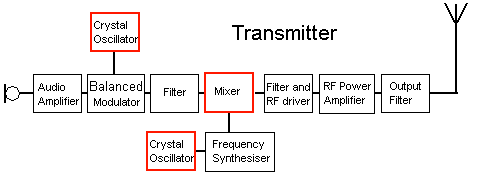|
|
|||||||||||||
|
|
|
||||||||||||
|
|
|||||||||||||
|
Syllabus Sections:- Mixers 4e.1 Understand that the desired frequency is often produced by mixing together the output from two or more frequency sources, e.g. v.f.o., crystal oscillator or synthesiser. Understand how unwanted frequencies may also be produced. |
|||||||||||||
|
You have seen this diagram before right at the start of this section on transmitters and receivers, but in this one the Crystal Oscillators and Mixer have been highlighted in red outline. Note that in the diagram there are two crystal oscillators used which feed via other circuits into the mixer to produce the wanted output frequency. In the Intermediate Course you saw that when two frequencies are combined in a mixer the output from the mixer has the two new frequencies formed in addition to the original two frequencies, which as far as the Intermediate Course went was all you needed to understand. Here is a reminder of this basic mixing:- These new frequencies are equal to the sum of the two original frequencies and the differences of the two original frequencies. Thus frequency 1 (f1) + frequency 2 (f2) = frequency 3 (f1+f2) and frequency 1 (f1) - frequency 2 (f2) = frequency 4 (f1-f2) ( assuming that f1 is greater than f2 otherwise use the frequencies the other way round f2 - f1 ). This might be easier to understand if we take a look at numeric values. if we have two frequencies say 15MHz and 5MHz and they are mixed the results would be Sum of:- 15MHz+5MHz= 20MHz Difference of:- 15MHz-5Mhz= 10 MHz By filtering, the frequencies that you do not want are removed. However from the earlier section in this course you now know that multiplies of the required frequency are also possible and these to also have the be filtered out. The mixed frequencies might also contain other unwanted components which have to filtered out. These unwanted frequencies are harmonics of the oscillators and the mixing process. |
|||||||||||||
|
|
|||||||||||||
|
|
|||||||||||||













